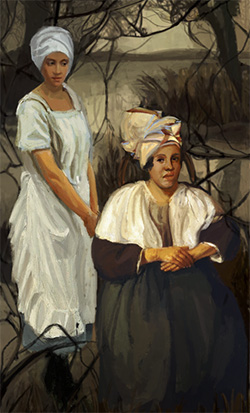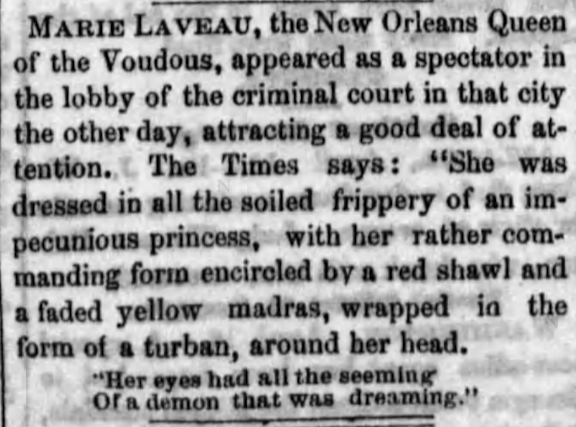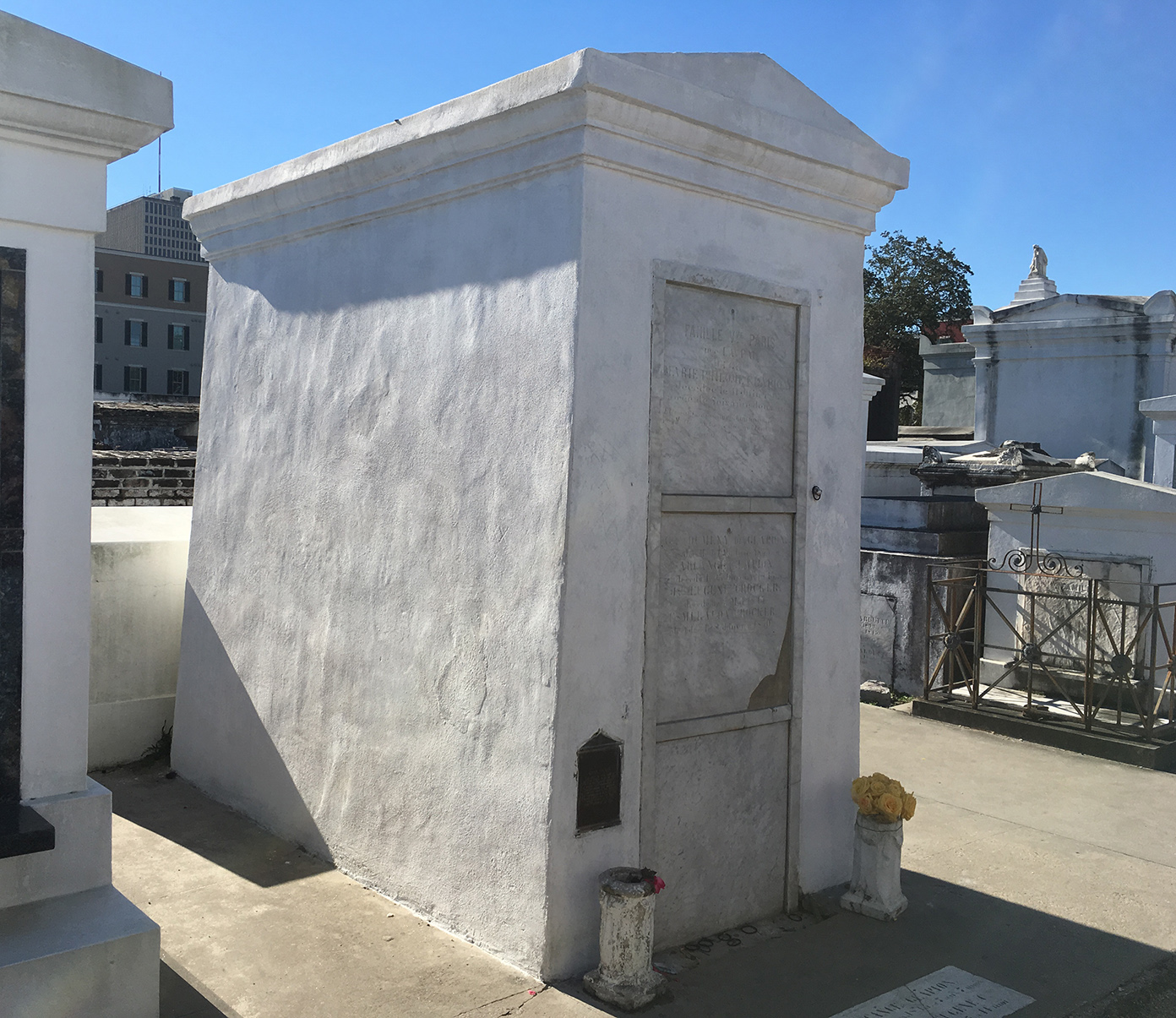Marie Laveau

Marie Catherine Laveau (September 10, 1801 – June 15, 1881) was a Louisiana Creole practitioner of Voodoo, herbalist and midwife who was renowned in New Orleans. Her daughter, Marie Laveau II, (1827–c. 1862) also practiced rootwork, conjure, Native American and African spiritualism as well as Louisiana Voodoo. An alternate spelling of her name, Laveaux, is considered by historians to be the original French spelling.
Early life
Marie Laveau was born a free woman of color in colonial New Orleans (today's French Quarter), Louisiana (New France), Thursday, September 10, 1801. She was the biological daughter of Charles Laveau, and her mother was Marguerite D'Arcantel.
On August 4, 1819, she married Jacques Paris (also known as Jacques Santiago in Spanish records), a Quadroon free man of color who had fled as a refugee from the Haitian Revolution in the former French colony Saint-Domingue. Following the reported death of her husband, she became known as "The Widow Paris," and entered a domestic partnership with Christophe Dominick Duminy de Glapion, a nobleman of French descent, with whom she lived until his death in 1855.
Voodoo Priestess
Marie Laveau was a dedicated practitioner of Voodoo, as well as a healer and herbalist. "Laveau was said to have traveled the streets like she owned them" said one New Orleans boy who attended an event at St. John's. Her daughter, Marie Laveau II displayed more theatrical rubrics by holding public events (including inviting attendees to St. John's Eve rituals on Bayou St. John). It is not known which had done more to establish the voodoo queen reputation, and she and her daughter are often regarded as a single entity.
Marie Laveau took short time to dominate voodoo culture and society in the New Orleans area, before becoming locally accepted as the Queen of Voodoo. During her decades as queen, customers often appealed to her for help with family disputes, health, finances, and more. Laveau performed her services in three main places: her own home on St. Ann Street, within Congo Square, and at Lake Pontchartrain. She was the third female leader of Voodoo in New Orleans (the first was Sanité Dédé, who ruled for a few years before being usurped by Marie Salopé). Marie Laveau maintained her authority throughout her leadership, although there was an attempt to challenge her in 1850. Due to her strong influence, New Orleans Voodoo lost a large number of adherents after her death.
Marie Laveau I started a beauty parlor where she was a hairdresser for the wealthier families of New Orleans. Of Laveau's magical practices, there is little that can be substantiated, including whether or not she had a snake she named Zombi after an African god, whether the occult part of her magic mixed Roman Catholic saints with African spirits and Native American Spiritualism, or whether her divinations were supported by a network of informants she developed while working as a hairdresser in prominent white households. She excelled at obtaining inside information on her wealthy patrons by instilling fear in their servants whom she either paid or cured of mysterious ailments.
Laveau was also known as a female religious leader and community activist. Her community activities included visiting prisoners, providing lessons to women of the community, and doing rituals for those in need.
Death
She died peacefully in her home on 15 June 1881 at the age of 79.
Crypt
Laveau's name and her history have been surrounded by legend and lore. She is generally believed to have been buried in plot 347, the Glapion family crypt in Saint Louis Cemetery No. 1, New Orleans, but this has been disputed by Robert Tallant, a journalist who used her as a character in historical novels.
Tourists continue to visit and some draw X marks in accordance with a decades-old tradition that if people wanted Laveau to grant them a wish, they had to draw an X on the tomb, turn around three times, knock on the tomb, yell out their wish, and if it was granted, come back, circle their X, and leave Laveau an offering.
Vandalism
In 1982, New Jersey-based punk rock group The Misfits were arrested and accused of attempting to exhume Laveau from her grave after a local concert. The arrest took place in nearby Cemetery No. 2 and there are conflicting accounts of the incident.
The tomb in Saint Louis Cemetery No. 1 was vandalized by an unknown person on December 17, 2013, by being painted over with pink latex paint. The paint was removed because the structure is made of old plaster and the latex paint would seal in the moisture that would destroy the plaster. Some historical preservation experts criticized the decision by officials of the Archdiocese of New Orleans, who maintain the cemetery, for their decision to use pressure washing rather than paint stripper to remove it.
Restrictions
As of March 1, 2015, there is no longer public access to St. Louis Cemetery No. 1. Entry with a tour guide is required because of continued vandalism and the destruction of tombs. This change was made by the Archdiocese of New Orleans to protect the tombs of the Laveau family as well as those of the many other dead interred there.
Legacy
Although some references to Marie Laveau in popular culture refer to her as a "witch," she is usually called a "Voudou Priestess," and or more frequently described as a "Voodoo queen." To practitioners of Louisiana Voodoo, Marie Laveau has achieved a unique status as a folk saint.
In popular culture
Laveau has offered inspiration for a number of fictional characters. She is the protagonist of such novels as Robert Tallant's The Voodoo Queen (1956); Francine Prose's Marie Laveau (1977); and Jewell Parker Rhodes' Voodoo Dreams: A Novel of Marie Laveau (1993).
In television, a heavily fictionalized Marie Laveau (portrayed by Angela Bassett) appears as a character in American Horror Story: Coven and American Horror Story: Apocalypse.
Laveau is mentioned in the songs "I Will Play for Gumbo" (1999) by Jimmy Buffett.

